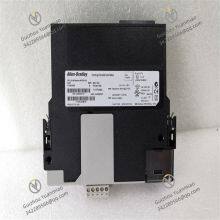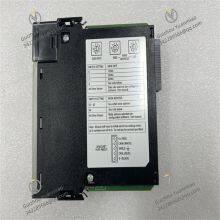I. Overview
1756-DNB is a module dedicated to DeviceNet network communication in Rockwell Automation's ControlLogix series, and it occupies an important position in device-level communication of industrial automation systems. Its core role is to build a connection bridge between the ControlLogix control system and the DeviceNet network, enabling efficient data interaction between the control system and underlying devices such as sensors, actuators, and small controllers.
With its in-depth support for the DeviceNet protocol and stable communication performance, this module is widely used in various industrial scenarios, especially in occasions that need to connect a large number of low-speed devices, such as automobile parts production lines, packaging machinery, and material conveying systems. It can upload the status data collected by underlying devices to the ControlLogix processor in real time, and at the same time accurately issue the control instructions of the processor to each device, realizing centralized monitoring and collaborative control of scattered devices, and providing reliable communication guarantee for the efficient and stable operation of industrial production.
1756-DNB needs to be installed in the ControlLogix 1756 series rack, work together with processor modules, I/O modules, etc., and integrate into the entire automation control system. Through close cooperation with other modules, it enables the control system to easily manage many underlying devices, simplifies the communication architecture between devices, and improves the integration and maintainability of the system.

II. Technical Parameters
Communication Protocol: Specifically designed to support the DeviceNet protocol, which is based on CAN bus technology. It is a low-cost device-level fieldbus protocol widely used in the industrial field, suitable for connecting various low-speed devices such as sensors, actuators, and human-machine interfaces, and can realize real-time data exchange and control command transmission between devices.
Communication Rate: Supports three selectable communication rates: 125kbps, 250kbps, and 500kbps. Users can flexibly configure according to the network scale, number of devices, and data transmission requirements. A lower rate is suitable for scenarios with a large number of devices and long communication distances, while a higher rate can meet the communication needs of small networks with slightly higher real-time requirements.
Network Interface: Equipped with a standard DeviceNet interface, adopting an open connector design, which is convenient for connecting with other devices in the DeviceNet network. It supports a bus-type network topology, simplifies on-site wiring, and reduces installation costs.
Power Requirements: Usually powered by a DC power supply, and specific parameters refer to the product data sheet. Its power supply design has good stability and anti-interference ability, and can continuously supply power to the module in complex industrial electromagnetic environments to ensure the continuity of communication.
Environmental Adaptability Range:
Operating Temperature: It can work stably within the temperature range of 0°C to 60°C, and can adapt to common temperature changes in industrial production sites, maintaining normal performance whether in high-temperature welding workshops or normal-temperature assembly areas.
Relative Humidity: It can withstand 5% to 95% non-condensing relative humidity, and can operate reliably in humid environments such as food processing workshops and around cleaning equipment, effectively avoiding communication failures caused by humidity issues.
Node Capacity: It can support up to 63 DeviceNet node devices to access, which can meet the equipment connection needs of small and medium-sized industrial networks, and the network scale can be flexibly expanded according to actual application scenarios.
Dimension Specifications: Adopting the standard module size of the ControlLogix series, it perfectly fits with the 1756 series rack. The installation process is simple, no additional space adjustment is required, which is convenient for system integration and later maintenance.

III. Functional Features
Focus on DeviceNet Communication with Stable Performance: 1756-DNB is specially designed for DeviceNet networks, with extremely mature support for this protocol, which can ensure the stability and reliability of communication with various DeviceNet devices. In the process of data transmission, it can effectively reduce problems such as packet loss and delay, ensure the accurate transmission of control instructions and status data, and provide a solid foundation for the collaborative work of underlying devices.
Flexible Rate Configuration to Adapt to Diverse Scenarios: Supporting three different communication rates allows the module to adapt to DeviceNet networks of different scales. For large networks with widely distributed and a large number of devices, a lower rate can be selected to ensure communication quality; for small networks with concentrated devices and slightly higher real-time requirements, a higher rate can be used to improve data transmission efficiency.
Powerful Network Management Capability: It has complete DeviceNet network management functions, which can scan, identify, and monitor the status of node devices in the network. The online status, communication quality and other information of each node can be viewed through programming software (such as Studio 5000), which is convenient for engineers to configure and maintain the network, and timely discover and deal with problems such as device offline and communication abnormalities.
Complete Diagnostic Functions for Easy Troubleshooting: It has rich diagnostic functions and can monitor the module's own operating status, network communication errors and other information in real time. When a fault occurs, the corresponding fault code will be displayed through indicator lights or programming software, helping maintenance personnel quickly locate the root cause of the problem, such as loose interfaces, equipment failures, network conflicts, etc., which greatly shortens the troubleshooting time and improves the maintenance efficiency of the system.
Easy Integration and Configuration: As a standard module of the ControlLogix series, 1756-DNB has excellent compatibility with other modules in the series and can be seamlessly integrated into the ControlLogix control system. Through Rockwell Automation's programming software, engineers can easily complete the parameter configuration of the module, network configuration, and connection settings with underlying devices without complex programming work, reducing the technical threshold of system integration.

IV. Application Scenarios
Automobile Parts Production Line: In the assembly line of automobile parts, there are a large number of sensors (such as position sensors, pressure sensors) and actuators (such as pneumatic valves, small motors). 1756-DNB can connect these devices through the DeviceNet network, collect the operating status data of each device in real time (such as whether the parts are in place, whether the assembly pressure is up to standard) and transmit it to the ControlLogix control system, and at the same time issue the assembly instructions of the control system to the corresponding actuators, realizing automatic control of the assembly process and ensuring the assembly quality and production efficiency of parts. For example, in the engine block assembly line, through the communication function of 1756-DNB, the control system can accurately control the torque of the tightening machine and obtain the tightening status in real time to ensure the tightening quality of each bolt.
Packaging Machinery: Packaging machinery contains many sensors for detecting the position, tension, and temperature of packaging materials, as well as actuators for driving conveyors and cutting devices. 1756-DNB can connect these devices to the DeviceNet network, enabling the ControlLogix control system to monitor various parameters in the packaging process in real time, such as whether the tension of the packaging film is appropriate, whether the cutting temperature is up to standard, etc., and adjust the actions of the actuators in time according to the monitored data to ensure the stability of packaging quality. For example, in food packaging machines, through the packaging film position signal transmitted by 1756-DNB, the control system can accurately control the film feeding speed to avoid problems such as packaging misalignment and missing seals.
Material Conveying System: In the material conveying system of automated warehouses or production workshops, there are a large number of conveyors, hoists and other equipment, which are controlled by multiple sensors (such as material detection sensors, position sensors) and motor drives. 1756-DNB can connect these devices to the DeviceNet network. The ControlLogix control system can obtain real-time data such as the position information of materials and the operating speed of equipment through this module, and then reasonably schedule the operation of each conveying equipment to realize efficient transfer of materials. For example, in the conveyor line of an express sorting center, 1756-DNB transmits the material detection signal of each sorting port to the control system, and the control system instructs the corresponding push rod action according to the signal to sort the express to the correct area.














































